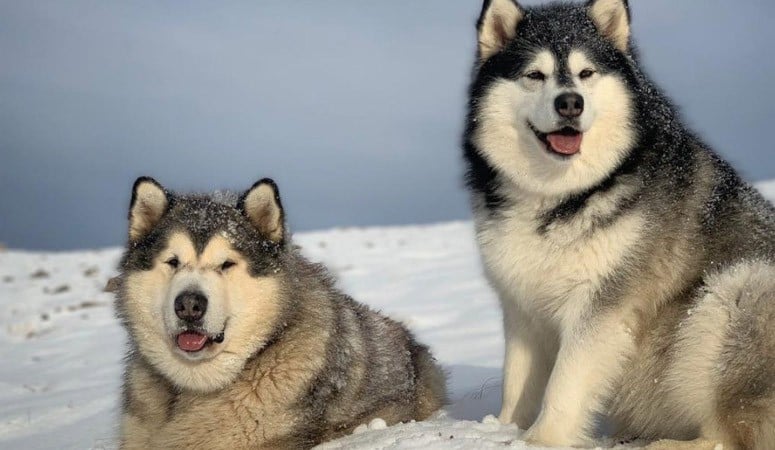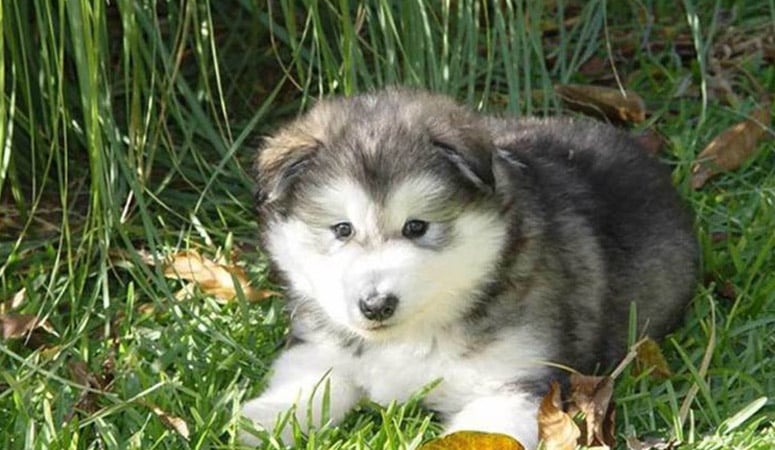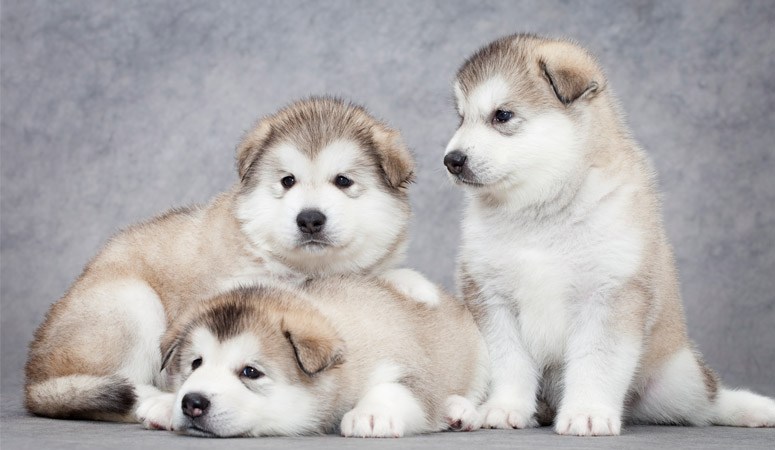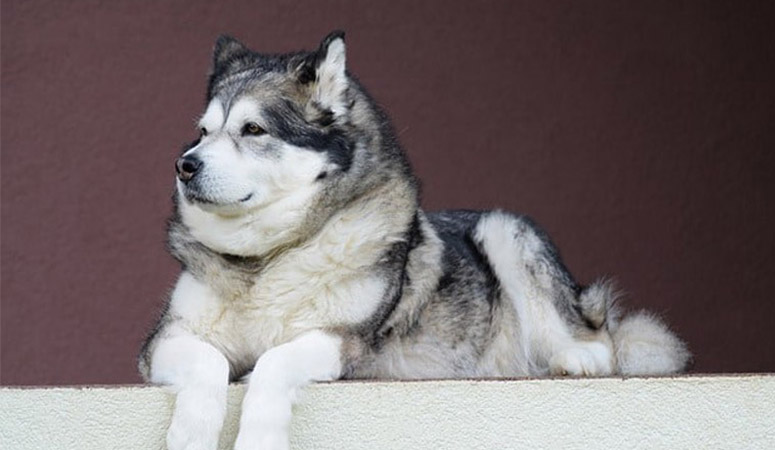Alaskan Malamute
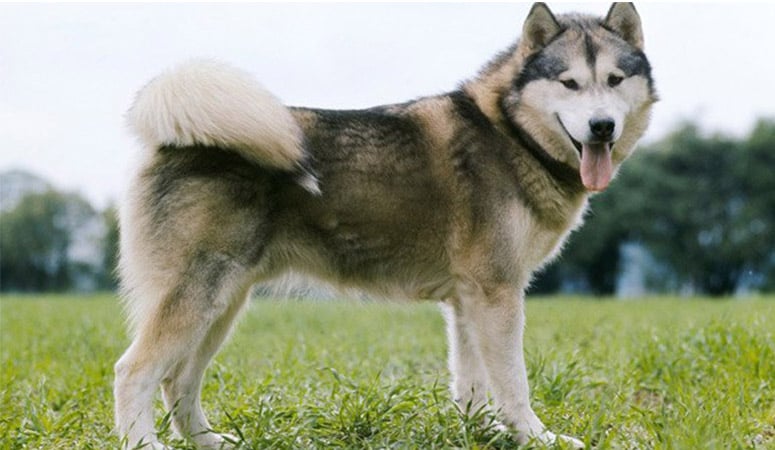
The Alaskan Malamute is intelligent, loving and affectionate. As a social breed, he is friendly to other pets or people. When becomes matured, he will behave with more confidence and calmness. With a powerful, sturdy body built, this breed excels in many training tasks and various sports. So he possesses great strength and stamina.
| Other Names | Al Mal, Malamute, Malamute De Alaska, Malamute De L’Alaska |
| Color | Gray & White, Sable & White, Black & White, Seal & White, Red & White, White |
| Height | Males: 25-28 inches. Females: 23-26 inches. |
| Weight | Males: 85-124 pounds. Females: 75-124 pounds. |
| Life Span | 10-14 years |
| Personality | Affectionate, Loyal, Playful |
| Exercise | Regular Exercise |
| Origin |
| Popularity | #64 |
| Groom Needs | 2-3 Times a Week Brushing |
| Kids Friendly | Yes with supervision |
| Dog Friendly | Yes with supervision |
| Watch Dog | |
| Family Dog | Yes |
| Litter Size | 4–10 |
Alaskan Malamute Pictures
Alaskan Malamute Video
Introduction
Recognizable by its plume tail which is amply covered with fur, is the cheerful Alaskan Malamute. A large breed of domestic dogs with strong and weighty bones, perhaps an adaptation for the hard work they engage in. They come in a thick double coat of sable, red, black, or gray color, often with white markings. There are all-white color varieties too.
A standard male stands to a shoulder height of about 24-26 inches. The females run quite smaller than the males and are likely to have a height of 22-24 inches. As medium-sized to large-sized dogs, Malamutes weigh somewhere between 75 and 85 pounds, with the males packing more muscle weight than the females. An Alaskan Malamute is a playful and devoted companion. If the conditions are right for its breeding, a Malamute would lead a dignified life, up to an impressive age of 11-14 years.
Living with Alaskan Malamute
With a dense double coat, the Alaskan Malamute needs regular brushing. The outer coat, as well as guard coat, is coarse and thick. It’s shorter and harder than the undercoat, which is woolly and oily to prevent cold and wetness. The undercoat is about 1 to 2 inches deep. So to keep your living environment clean and body health, regular brushing is needed. Usually one to three times a week is enough, which can help distribute skin oils and keep the breed’s coat clean. Malamutes should shed heavily twice a year. When the breed’s hair falls out in large clumps, frequent brushing with a slicker brush is necessary, which is helpful to control its hair flurry. Malamutes usually keep their coats clean and are easy to housetrain. So it’s rarely needed for the breed to bath. If the dog does not get into a smelly mess, once or twice a year is enough. Besides, to keep health body, brushing teeth two or three times a week and trimming nails once or twice a month are required under the point of a groomer if you don’t know.
The Alaskan Malamute is a member of the Working Group of dogs. They need daily exercise to make them athletic and strong and keep their tremendous endurance. As task seekers, they are excellent in sports, for example, hikes, sledding, carting, skijoring(pulling a person on skis), swimming and long walks with heavy loads. The owners and Malamute should romp in the well-fenced yard or enclosed place with enough time. Besides, Malamutes also can participate in backpacking, weight-pulling competitions and obedience and agility trials. In general, they need to play, run and bounce a lot. Exercise is related to Malamutes’ activity level, health condition and age, so the owner must make sure the exercise adequate.
To meet the needs of high energy and exercise, you should give Alaskan Malamute an proper diet, including size and portion when you feed them. And with growing from puppyhood to adulthood and senior age, their needs of food will also change. So you should provide high-quality dog food that is home-prepared or manufactured by commerce for them under the veterinarian’s supervision and approval, so that they could keep on top of these nutritional requirements. You should care about your dog’s weight, because they are easy to get overweight. When feed Malamute you should control the calorie and avoid giving too many. Besides, fresh, clean water should always be available. And if there are any concerns about dog’s diet, you should ask the vet in time.
Malamutes usually are healthy, but sometimes they also get into certain health problems, for example, hip dysplasia, hypothyroidism, von Willebrand’s disease and elbow dysplasia. hip dysplasia is hereditary. Dogs with hip dysplasia, their thighbone doesn’t fit snugly into the hip joint. So they may feel lameness and pain on one or both rear legs. Besides, cataracts,chondrodysplasia, inherited polyneuropathy and hemeralopia(day blindness) occur occasionally. So it’s important to know what to do to with such health problems. Screening breeding stock for health conditions would be helpful. Checking the ears regularly would help avoid a buildup of wax and remove foreign matter. Weekly exam can help you spot potential health problems early. Here are some recommended health tests:
- Hip Evaluation
- Polyneuropathy DNA Test
- Ophthalmologist Evaluation
Total Annual Cost: $3562.9
Cost is estimated for the first year and may vary depending on many factors, such as dog food, health care, leash, collar, licensing, possible fencing, crates, training and obedience classes, dog-walking, grooming, treats, toys, flea, tick, and heart-worm meds, microchips, etc.
With intelligence, strength and size, Malamutes should be given obedience and socialization training from a young age, which can keep them from being pushy with pets and kids and outwitting or outmaneuvering the owners. Malamutes like digging. So you should not stop such behavior, but accept this habit and prepare a place for him in your yard that you don’t mind and the yard fencing must continue into the ground. Being friendly to every people or pet they meet, Malamute cannot be regarded as good guard dogs. Malamutes are very willing, independent, and sometimes are stubborn, so the owner needs great patience and fairness during the training
History
The name, Malamute, is derived from the Mahlemut, an Inuit tribe that occupied the Kotzebue Sound in northwestern Alaska. The Alaskan Malamute is believed to have descended from the old wolf-dogs which accompanied certain Paleolithic hunters across the Bering Strait some thousands of years ago. They are acclaimed as the oldest of all sled dogs to have existed. The Alaskan Malamute was bred as something of a utilitarian nature, they were more or less versatile working dogs, hunting dogs, packing dogs, and sled dogs.
The Inuit heritage spread across Alaska up to the Arctic northern countryside of Greenland. Considering the expansive size of the region occupied by this tribe, the breed was subject to variation in patterns of breeding from a part of Alaska to another, even up to Greenland. Hence, it is no odd occurrence that there should be different genetic strains of the same dog breed across these regions. The Alaskan Malamute was never created to be a race dog, unlike some of the other sled dogs, such as the Siberian Husky. The Malamute was more of a slow-paced freight breed for heavy loads, especially in old Europe.
During the 1896 Klondike Gold Rush, the Malamute and other sled dogs were of immense help to gold prospectors of the Arctics. The Kotzebue strain of the Malamute gained recognition around 1935, owing to the efforts of one Mrs. Eva B. Seeley. After World War II, the population of the Malamute had diminished, which prompted the AKC to reopen the studbook for the inclusion of M’Loot and Hinman strains, mainly through the efforts of Robert J. Zoller.
Helpful Information
Breed Club: ALASKAN MALAMUTE CLUB OF AMERICA, INC.
Breed Club Link: http://alaskanmalamute.org/
Breed Club Rescue: Alaskan Malamute Assistance League
Breed Club Rescue Link: https://www.malamuterescue.org/index.php/rescue-affiliates/

